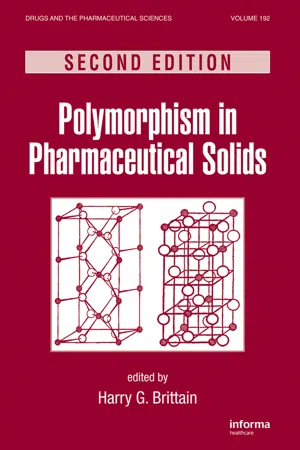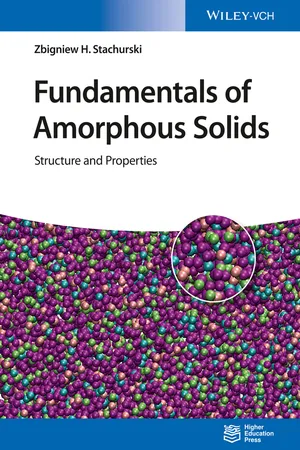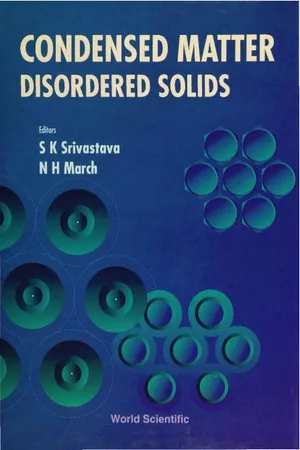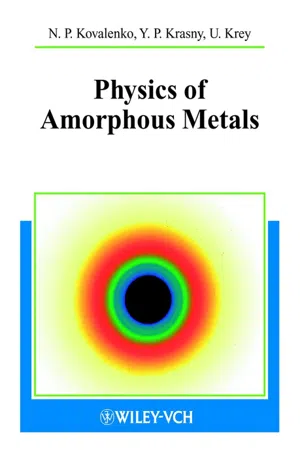Physics
Amorphous Solid Structure
Amorphous solid structure refers to the arrangement of atoms or molecules in a non-crystalline, disordered manner. Unlike crystalline solids, amorphous solids lack a regular, repeating pattern in their atomic structure. This results in unique physical properties, such as lack of a distinct melting point and isotropic behavior, making them important in various applications like glass and plastics.
Written by Perlego with AI-assistance
Related key terms
1 of 5
11 Key excerpts on "Amorphous Solid Structure"
- eBook - PDF
- Harry G. Brittain(Author)
- 2018(Publication Date)
- CRC Press(Publisher)
The importance of temperature to the macroscopic behavior and the underlying molecular level structure will be addressed in much greater depth throughout this chapter. The feature that distinguishes the amorphous “solid” from a crystalline solid is the absence of repeat three-dimensional order that persists over long length scales (i.e., many, many molecules). Amorphous solids do show short-range order (2), and in many cases the short-range order is similar to that seen in a liquid. Essentially, this means that nearest neighbor interactions are maximized in the amorphous solid where possible, to obtain a local minimum in the free energy. The short-range order found in amorphous substances stems from packing of the molecules to form near-est neighbor interactions through van der Waals interactions, hydrogen bonding, or electrostatic interactions, and the local packing may or may not be similar to the short-range order found in the crystalline counterpart. The locally favored structure is not periodic over long distances. Thus, amorphous materials are isotropic over longer length scales, whereas most organic crystals display directionally dependent properties as a result of their three-dimensional order. Accompanying the more random arrangement of molecules in amorphous materials is a higher free volume compared to a crystalline solid. Free volume can be determined quantitatively by the difference in the total volume and the molecu-lar volume as defined using van der Waals radii. - eBook - ePub
- Siegfried Hunklinger, Christian Enss(Authors)
- 2022(Publication Date)
- De Gruyter(Publisher)
3 The Structure of SolidsAfter getting to know the different types of bonds, we turn to the spatial arrangement of atoms and molecules in solids in this chapter. Here, an important aspect is the distinction between crystals and amorphous solids. While crystals are characterized by their regular atomic structure, the structure of amorphous materials is irregular. However, before we examine the structure of the two different classes of solids more closely, we will briefly discuss their production, since it determines whether atoms form well-defined crystals or disordered amorphous solids. In this context, we will also discuss the peculiarities of the production of alloys. Closely linked to the question of structure is the further question of the type of order or disorder. We will also briefly address this point3.1 The Production of Crystalline and Amorphous Solids
Except for organic materials, most solids are formed by cooling their melt. A typical, well-known example of this is the solidification of water into ice. In this chapter, we first deal with the question of under which circumstances ordered crystals are formed from the melt and under which disordered amorphous solids are produced.3.1.1 Single Crystal Growth
In general, when a melt is cooled and no special precautions are taken, polycrystalline solids are usually formed. These consist of small crystallites which are connected to each other via largely disordered interfaces. Under certain conditions, single crystals - eBook - PDF
- Richard Zallen(Author)
- 2008(Publication Date)
- Wiley-VCH(Publisher)
The structure (static for the glass, everchanging for the liquid) is of the type indicated in Fig. 1.66 for both materials, but the motion is as in Fig. 1 . 7 ~ for the solid container and as in Fig. 1.7b for its fluid contents. Amorphous solids are bona fide solids, having all of the requisite elastic properties (shear stiffness, etc.). There is no need to belabor this point, many of the applications of these materials (look ahead to Table 1.2) rely explicitly on properties such as rigidity and strength. Note that neither the macroscopic (rigidity, etc.) nor the atomic (Fig. 1 . 7 ~ ) description of solidity makes any reference to the presence or absence of structural long-range order, indeed, solidity is not synonymous with crystallinity. It should not be necessary any longer to emphasize that solidity # crystallinity. Unfortunately, it is, in fact, necessary to do so. The reason for this necessity arises from the following circumstance: Amorphous solids are rarely included in textbooks on solid-state physics. If one were tempted to define the subject of “solid-state physics” by the content of current textbooks with that title, one might erroneously conclude that solid-state physics is synonymous with crystal physics. So much is this the case, in fact, that it is standard procedure for a course on the physics of solids to begin with a discus- sion of crystal lattices and translational periodicity as ifperiOdiGity were a p r e y -uisitefor solidity. Since it blithely ignores an entire important class of solids, this attitude is completely wrong. This mistaken premise, the exclusive association of solidity with crys- tallinity, brings us to the third in the troika of topics listed in the title of this section. This topic has to do with the issue of the respectability of amorphous solids as proper inhabitants of the solid state. - eBook - ePub
- Marc Descamps(Author)
- 2016(Publication Date)
- Wiley-VCH(Publisher)
The differences in behavior between the different types of solids are fundamentally associated with the peculiarities of the molecular disorder. In the pharmaceutical literature related to amorphous solids, most interest has been focused on the molecular mobility and the way it may impact stability [8]. If mobility obviously plays an important role, many other aspects of the disorder also can determine the stability level of solids [9]. In this chapter we examine some of the facets of disorder that make it possible to differentiate between crystalline and amorphous states and also between various amorphous states of the same compound. That requires considering the structural, dynamic, thermodynamic, and even kinetic aspects of disorder.1.1 The Crystal/Amorph Alternative
1.1.1 Crystal/Amorph Alternative: Terminology and Solidity Concept
Condensed matter can normally come in two forms: liquid and solid. The distinction between liquid and solid states lies in how they respond to the application of a shear stress.A liquid deforms continuously when it is subjected to a shear stress: it is a fluid form of condensed matter.A solid, on the contrary, can support a shear stress without flowing. If the shear is not too strong, it will deform elastically. This means that when the external forces are removed, an elastically deformed solid returns to its initial state: it is a rigid form of matter.Solids can be either crystalline or amorphous: they differ in their structure and in the way they are solid.Perfect crystals are those in which a “motif” – formed by a limited number of atoms or group of atoms – is repeated periodically in a three-dimensional array (lattice). This is reflected in the specific external shape that the crystals can adopt. The equilibrium state of a material at low temperature is expected to be crystalline.The amorphous state - eBook - ePub
Fundamentals of Amorphous Solids
Structure and Properties
- Zbigniew H. Stachurski(Author)
- 2015(Publication Date)
- Wiley-VCH(Publisher)
This relationship accounts for the variation of glass density with the internal atomic arrangements (inherent structure), which is formed at different cooling rates, shown schematically in Figure 3.3. The formation of random clusters implies a distribution of coordinations that results in local density variations (see Figure 2.7), and the density of glass is varied by formation of imperfections in the random packing of atoms or by reducing and redistributing free volume. Theory of amorphousness, as outlined in this book, provides the basis for defining the amorphous nature of glassy solids by the full description of the ideal amorphous solid (IAS). In the second part of this chapter, a number of glassy materials are idealized and their atomic arrangements are described in terms of the IAS model defined in Chapter 1. The relationship between the theory of amorphousness and theory of crystallography and the full range of solid-state structures is shown schematically in Figure 3.4. Figure 3.4 Schematic diagram of possible structural evolutions in a hypothetical substance that can form glass as well as grow into a single crystal. The relevance of the theories of amorphousness and crystallography to the world of materials science is indicated. In considering amorphous structures, we discount solids that are crystalline materials but disordered to such an extent that long-range atomic order becomes undetectable. This corresponds to the case when atomic arrangement is disrupted, say, by heavy particle bombardment leading to the so-called ‘amorphous’ structure (Johannessen et al., 2007) or by heavy mechanical working (deformation). In principle, these solids can be restored to crystalline order by a suitable annealing - eBook - ePub
Physical Metallurgy
Principles and Design
- Gregory N. Haidemenopoulos(Author)
- 2018(Publication Date)
- CRC Press(Publisher)
unit cell , as well as the arrangement of atoms within the unit cell. The way towards creating links between structure and properties of metals was established. A complete coverage of the science of crystallography is out of the scope of this chapter. Only fundamental elements, especially those which highlight the correlation between structure and properties of metals, will be discussed here. For a more complete treatment, the reader is advised to study the bibliography at the end of this chapter.2.2 Crystalline vs. Amorphous Materials
As discussed above the crystal structure is an orderly and periodic array of atoms. Not all materials exhibit a crystal structure. In crystals, when the liquid is cooled below the freezing point, it transforms into a crystalline solid. Some liquids, however, due to either a complex atomic configuration or limited atomic mobility, do not organize into a crystalline arrangement, but instead they form a disordered array of atoms. Actually this disordered state resembles the atomic arrangement in the liquid state and is called a glass . Glasses lack long range order and are therefore amorphous materials . The transition from the liquid to the glassy or amorphous state is gradual and takes place at theglass transition temperature Tg. On the other hand the transition from the liquid to the crystalline state for crystalline materials is abrupt, and takes place at themelting point Tm. Although metals are generally crystalline, it is possible, under certain conditions, to produce amorphous metals, called metallic glasses . Metallic glasses can be produced by rapid solidification of metal droplets or by vacuum deposition on a substrate at low temperatures and exhibit interesting properties. Glasses are isotropic materials, i.e., they exhibit the same physical and chemical properties in all directions. On the other hand, crystalline materials are anisotropic and properties, such as thermal or electrical conductivity, thermal expansion and elastic constants depend on the direction of measurement. The anisotropy of crystals is exhibited during unconstrained crystal growth, where the external free surface of the growing crystal develops facets, associated with the crystal structure in the bulk of the material.2.3 The Crystal Lattice
As discussed above, a crystal is a periodic array of atoms in three-dimensional space. This structure can be described with respect to a three-dimensional net of straight lines, called the lattice . An example is depicted in Figure 2.1 . The lattice divides space into cells, defined by the unit vectorsanda →,b →c →. The cells are in contact on all faces and fill space entirely. The cell is then called the unit cell , since it plays the role of the building block for the whole crystal. Its repetition in three directions generates the crystal structure. The unit vectors define the periodicity of the crystal in the three directions. Every node of the lattice can be defined by the position vectorr → - eBook - PDF
- John Loveday(Author)
- 2012(Publication Date)
- Chapman and Hall/CRC(Publisher)
4 Amorphous materials Glasses and amorphous materials are non-crystalline and posses some degree of randomness, in the form of topological or spin disorder but it is not unique. Such a definition for example necessarily describe a non-crystalline state as many crystals are imperfect containing vacancies, substitution disorder etc. Topological disorder is the form of randomness in which there is no transla-tional periodicity and this provides us with a definition of an amorphous ma-terial [10, 11]. An amorphous material is synonymous with a non-crystalline material by this definition, in other words an amorphous material does not posses the long-range order that is characteristic of a crystal. The term glass is more restrictive. A glass is a solid amorphous phase that exhibits an abrupt change in thermodynamic properties (heat capacity or thermal conductivity) from crystal-like to liquid-like values with temperature. This definition distin-guishes glasses (or the vitreous state) from amorphous materials which can include liquids, glasses are restricted in definition to those materials that can be obtained in a reproducible state even after thermal recycling. The oldest and most well-established method of forming amorphous solids is to cool the liquid sufficiently quickly. Although materials produced in this way invariably show glassy behaviour the feature of this melt-quenching pro-cess is continuous hardening, in other words and increase in viscosity. A pre-requisite to formation of an amorphous material by this technique is that the cooling must be sufficiently fast to avoid nucleation. This depends on the speed at which the crystal-liquid interface moves and scales with viscosity. It is easy to identify liquids that might be expected to be good glass for-mers; liquids with high viscosity and which reflect competing timescales that result from the free energy difference between crystals and liquids. This is a - eBook - ePub
Solid State Physics
An Introduction
- Philip Hofmann(Author)
- 2015(Publication Date)
- Wiley-VCH(Publisher)
1 Crystal StructuresOur general objective in this book is to understand the macroscopic properties of solids in a microscopic picture. In view of the many particles in solids, coming up with any microscopic description appears to be a daunting task. It is clearly impossible to solve the equations of motion (classical or quantum mechanical). Fortunately, it turns out that solids are often crystalline, with the atoms arranged on a regular lattice, and this symmetry permits us to solve microscopic models, despite the very many particles involved. This situation is somewhat similar to atomic physics where the key to a description is the spherical symmetry of the atom. We will often imagine a solid as one single crystal, a perfect lattice of atoms without any defects whatsoever, and it may seem that such perfect crystals are not particularly relevant for real materials. But this is not the case. Many solids are actually composed of small crystalline grains. These solids are called polycrystalline, in contrast to a macroscopic single crystal, but the number of atoms in a perfect crystalline environment is still very large compared to the number of atoms on the grain boundary. For instance, for a grain size on the order of atomic distances, only about 0.1% of the atoms are at the grain boundaries. There are, however, some solids that are not crystalline. These are called amorphous. The amorphous state is characterized by the absence of any long-range order. There may, however, be some short-range order between the atoms.This chapter is divided into three parts. In the first part, we define some basic mathematical concepts needed to describe crystals. We keep things simple and mostly use two-dimensional examples to illustrate the ideas. In the second part, we discuss common crystal structures. At this point, we do not ask why the atoms bind together in the way that they do, as this is treated in the next chapter. Finally, we go into a somewhat more detailed discussion of X-ray diffraction, the experimental technique that can be used to determine the microscopic structure of crystals. X-ray diffraction is used not only in solid state physics but also for a wide range of problems in nanotechnology and structural biology. - eBook - PDF
- Toshio Itami, Norman H March, Fabio Siringo(Authors)
- 1995(Publication Date)
- World Scientific(Publisher)
The development of disordered materials such as amorphous alloys and ferromagnetic glasses stimulates current interest in this rapidly growing field. There is also an increasing need for understanding the structure-property relationships of disordered systems, because of the novelty of the physics related to the particular non-periodicity in their atomic arrangements. In the 1980's, the systematic structural investigation of disordered systems, liquids and amorphous solids, by x-ray and neutron diffraction was carried out and then several advances have been made only recently, although this research field itself has long been studied in the past. The main purpose of this chapter is to describe the current experimental information on the structure of liquids and amorphous solids which is not covered in the monographs and review chapter previously published. The subject matter in this chapter is treated selectively rather than comprehensively and the examples are taken mainly from the results obtained by our group in the Institute for Advanced Materials Processing, Tohoku University; structure factors of liquid metals in the low wave vector region, the distribution of valence electrons around an ion in liquid metals, compound forming and structural inhomogeneity in liquid alloys, and structure of oxide melts and glasses. The description of the atomic scale structure of disordered systems usually 3 employs the concept of the radial distribution function (RDF) which can be obtained by diffraction experiments of x-rays and neutrons [see for example,Warren 4 ', Klug and Alexander^]. Since the usual RDF data is known to be only one dimensional and average information, a large amount of experimental and theoretical effort have been devoted to the development of techniques for obtaining the partial structural functions of the individual chemical constituents or the local chemical environment structure around a specific element in multicomponent disordered systems. - No longer available |Learn more
Mechanical Engineering Exam Prep
Problems and Solutions
- Layla S. Mayboudi, S. Musa, PhD(Authors)
- 2021(Publication Date)
- Mercury Learning and Information(Publisher)
(a) reaches an equilibrium state and forms a semi-crystalline structure (b) does not reach an equilibrium state and forms an amorphous structure (c) reaches an equilibrium state and forms an amorphous structure (d) does not reach an equilibrium state and forms a semi-crystalline structure- Amorphous to crystalline is like: (a) melting temperature to glass transition temperature (b) glass transition temperature to melting temperature (c) glass transition temperature to critical temperature (d) critical temperature to melting temperature
- Two identical molten materials starting from the same initial state can reach different final states after a cooling process. (T/F)
- Amorphous materials have a . . . and crystalline materials have a . . . (a) long-range order structure / short-range order structure (b) short-range order structure / short-range order structure (c) long-range order structure / long-range order structure (d) short-range order structure / long-range order structure
- Glasses in high-pressure form: (a) disordered structures, forming short-range orders (b) ordered structures, forming long-range orders (c) disordered structures, forming long-range orders (d) ordered structures, forming short-range orders
- Short-range order is: (a) hundred-length bonds expanding to many (b) the regular and predictable arrangement of the atoms over a short distance (one to two atom spacings) (c) ten-length bonds (d) a statistically significant bond length (> 100)
- How many atoms are contained in one mole? (a) the Knudsen number (b) depends on the material’s density (c) depends on the molar weight (d) the Avogadro number
- In order to characterize the material’s structure quantitatively, . . . is(are) used: (a) descriptors (b) indices (c) symmetry properties (d) melting temperature
- Atomistic descriptors predict . . . ; statistical descriptors predict . . .
- eBook - PDF
- Nikolai P. Kovalenko, Yuri P. Krasny, Uwe Krey(Authors)
- 2008(Publication Date)
- Wiley-VCH(Publisher)
3.1.4 The excess density of states for vibrational modes determined by inelastic neutron scattering (solid line) compared with the Debye density for vibrational modes (taken from Galperin et al., 1989, Fig. 3, accord- ing to Buchenau et al., 1986) urations fR j g m describing metastable states (where m is the configurational in- dex and R j is the radius vector of the j th atom). However, the fixed positions R j of the atoms in amorphous solids are not in true thermodynamic equilibrium, and by thermal or quantum fluctuations the system may drift slowly from one metastable state to another, which leads to the already mentioned ‘aging’ of the physical properties, or the system may even relax very slowly to the basic config- uration of a crystalline lattice. However most of the metastable states are widely apart in configurational space, and the relaxation times are therefore large – sig- nificantly larger than the characteristic times of a typical experiment. So on the timescales of most experiments amorphous solids may be considered as thermo- dynamically stable systems with quasi-equilibrium atomic coordinates. Conse- quently, the measurable characteristics of a quasi-equilibrium configuration of atoms may be calculated with the methods of equilibrium statistical mechanics, namely by Gibbs averaging over the degrees of freedom of quickly relaxing sub- systems (the phonons, electrons, spins, etc.) (Mazo, 1963; Juchnovsky and Gurski, 1991). However the observables (such as free energy, heat capacity, magnetic mo- ment, etc.) should not depend on the concrete positions of atoms, in view of the macroscopic number of equivalent configurations. Because of this self-averaging property of these variables in amorphous systems, the observables are usually aver- aged over all typical realizations of the random configurations of atoms in the sys- tem.
Index pages curate the most relevant extracts from our library of academic textbooks. They’ve been created using an in-house natural language model (NLM), each adding context and meaning to key research topics.










